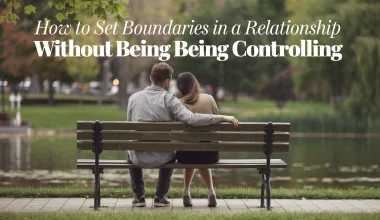Healing from emotional wounds and personal struggles is often seen as a solitary journey. However, many people wonder if it’s possible to heal while still being in a relationship.
Relationships can provide love, support, and comfort, but they can also introduce challenges that might complicate healing. Understanding how to balance self-care with nurturing a relationship is essential for emotional recovery.
In this post, we’ll explore how healing works within a relationship, the challenges it presents, and practical steps you can take to support both your healing and the relationship.
What is Healing in a Relationship?
Healing is the process of recovering from emotional pain, past trauma, or personal difficulties. It involves understanding and managing difficult emotions, as well as gaining insight into past experiences.
Everyone’s healing process is unique, but it generally includes steps like self-reflection, letting go of past hurts, and rebuilding emotional strength.
In the context of a relationship, healing can happen in two ways: through support from a partner and through personal growth. Healing within a relationship means that while the process remains individual, the relationship plays a significant role in how a person heals.
It can be challenging to heal from past wounds while also maintaining a relationship, as partners often bring their own emotional baggage to the table. Despite this, a healthy relationship can enhance the healing process by providing emotional safety, trust, and understanding.
Why Are Toxic Relationships Addictive
However, healing isn’t a quick fix or something that can be entirely solved by another person. True healing often requires time, self-awareness, and a willingness to process emotions independently.
How Relationships Can Help Heal
- Emotional Support
Emotional support is one of the most crucial elements for healing within a relationship. A partner who listens without judgment, offers compassion, and provides comfort can help you feel understood and less alone in your pain.
This support creates an emotional safety net that allows individuals to open up and work through their issues, knowing they have someone to rely on. However, it’s important that this support does not become the sole means of healing, as over-reliance on a partner for emotional support can create dependency. - Healthy Communication
Open and honest communication is key to healing in a relationship. When partners talk openly about their feelings, both can better understand each other’s experiences and struggles.
Healing often requires addressing past wounds, and discussing these openly with a partner can lead to clarity, emotional release, and mutual support. Couples who maintain healthy communication are better equipped to navigate difficult emotions together, which can ultimately help both partners heal. - Shared Experiences and Growth
Going through life’s challenges together can create stronger bonds between partners. When two people face challenges, heal from trauma, and grow together, they can create a foundation of resilience.
Healing while in a relationship is often easier when partners have shared experiences that bring them closer together, fostering understanding and compassion. These shared experiences build a deeper connection and promote emotional growth, which can benefit the individual and the relationship as a whole.
Challenges of Healing While in a Relationship
- Emotional Dependency
One of the biggest risks when healing in a relationship is emotional dependency. This occurs when one partner relies too much on the other for emotional stability. While a partner can provide support, healing requires self-care and inner work.
Relying on someone else to “fix” you can prevent true emotional growth and make you feel stuck. A healthy relationship requires a balance of supporting each other while also being strong individuals who can process emotions independently. - Unresolved Past Trauma
Sometimes, past trauma or emotional wounds can resurface within a relationship. Unhealed wounds might influence how you interact with your partner, causing unnecessary conflict or emotional distance.
If one partner hasn’t fully processed their past, it may be difficult for them to fully engage in a relationship, as they may bring their unresolved issues into their current dynamic. In these cases, it’s essential to recognize the role of past experiences and address them before they cause further harm. - Pressure to Heal Quickly
In a relationship, there may be pressure to “get over” past hurts or heal quickly for the sake of the relationship. A partner who is supportive might unintentionally rush the healing process, thinking that moving on quickly will benefit both individuals.
However, healing is a gradual process that cannot be rushed. If either partner feels pressured to heal at an unrealistic pace, it can lead to frustration, resentment, and emotional strain. True healing cannot be forced; it must unfold at its own pace.
How to Set Boundaries in a Relationship
How to Heal While in a Relationship
- Set Boundaries
Setting emotional boundaries is an essential step in balancing healing and relationship dynamics. Healthy boundaries allow you to prioritize your emotional well-being without isolating your partner.
Communicate your needs clearly, whether it’s needing space, time to process your thoughts, or the kind of support you’re looking for. Boundaries also help maintain a sense of autonomy, so that both partners can continue growing while staying connected. - Practice Self-Care
Self-care is a crucial aspect of healing. It involves taking care of your body, mind, and emotions. Practicing self-care could mean going for a walk, journaling, meditating, seeing a therapist, or simply taking time to relax.
Prioritize self-care to avoid burnout and maintain emotional balance. By focusing on your well-being, you can better contribute to a healthy and supportive relationship. - Foster Open Communication
Constant communication is key to ensuring both partners understand each other’s healing process. Be open about your emotions, struggles, and what you need from your partner.
Similarly, be receptive to your partner’s needs as well. Healing is a shared experience in many ways, and healthy communication is what helps both partners grow and heal together. - Seek Professional Support
Sometimes, healing requires external help. Therapy or counseling can provide a neutral space to work through emotional issues with the help of a professional.
Individual therapy can be an essential tool for self-reflection, while couples therapy can address relational dynamics and improve communication. Healing doesn’t have to happen alone, and professional support can guide you through the process.
Signs You May Need Space
- Overwhelm
If you’re feeling emotionally drained or overwhelmed by the demands of the relationship, it may be a sign that you need some space.
It’s important to step back and reflect on your emotional needs without the added pressure of a relationship. - Difficulty Processing Emotions
Sometimes, healing requires time alone to fully process emotions. If you’re unable to fully address your feelings with your partner, taking space to focus on your inner work can allow you to heal at your own pace. - External Support is Needed
If healing requires professional intervention, don’t hesitate to seek therapy or counseling. A therapist can help you address deeper emotional wounds that may not be resolved within the relationship alone.
Can Love and Healing Coexist?
Yes, love and healing can coexist, but balance is essential. A loving partner can help you heal, but it’s crucial that you also work on healing as an individual.
Both elements (love and personal growth) are necessary for long-term emotional well-being. The key is to maintain a healthy, supportive relationship while still dedicating time and effort to your own emotional recovery.
FInal Thought
Healing while in a relationship is possible, but it requires awareness, boundaries, and self-care. Relationships can provide vital support, but emotional healing is a personal process that should not rely entirely on your partner.
By setting boundaries, practicing self-care, and communicating openly, you can find a balance that allows you to heal while maintaining a healthy and loving relationship.






